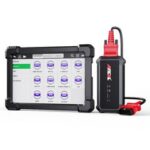OBD2 (On-Board Diagnostics II) is a standardized system that allows technicians and car owners to diagnose vehicle problems. Understanding OBD2 codes, especially permanent codes, is crucial for addressing underlying issues. This article delves into the meaning of OBD2 permanent codes, focusing on their significance in diagnosing emission-related problems.
Types of OBD2 Diagnostic Trouble Codes (DTCs)
There are three primary types of generic OBD2 codes:
Pending Codes: Early Warning Signs
Pending codes indicate a potential problem detected by the vehicle’s onboard computer. These codes don’t illuminate the check engine light and suggest that a system is operating outside its normal parameters, but not yet to a degree considered a fault. For instance, a temperature sensor reading slightly outside its ideal range might trigger a pending code.
Confirmed Codes: Active System Faults
Confirmed codes signify an active issue requiring attention. These codes illuminate the check engine light and indicate that a system has exceeded acceptable operating limits. Continuing with the temperature sensor example, a reading significantly below or above the acceptable range would result in a confirmed code.
Permanent Codes: Emission-Related Concerns
Permanent codes are a specific type of confirmed code related primarily to emissions systems. They cannot be cleared using a standard OBD2 scanner, even after fixing the underlying problem. The vehicle’s computer automatically clears a permanent code after it verifies the issue is resolved and the system operates correctly over a specific period and under varying driving conditions (idle, city driving, highway driving). This ensures compliance with emission regulations.
Why are Permanent Codes Important?
Permanent codes play a crucial role in ensuring vehicle emissions remain within acceptable limits. They provide a record of emission-related faults, preventing temporary fixes that might allow a vehicle to pass an emissions test but not address the underlying problem. This helps maintain air quality and ensures vehicles operate efficiently.
Common Causes of Permanent OBD2 Codes
Several issues can trigger permanent OBD2 codes, typically related to the emissions system. Some frequent culprits include:
- Faulty Catalytic Converter: A malfunctioning catalytic converter, responsible for reducing harmful emissions, often results in a permanent code.
- Oxygen Sensor Problems: Issues with oxygen sensors, which monitor the exhaust gas composition, can trigger permanent codes.
- Evaporative Emission System Leaks: Leaks in the evaporative emission system, designed to capture fuel vapors, often lead to permanent codes.
- EGR System Malfunctions: Problems with the Exhaust Gas Recirculation (EGR) system, which reduces nitrogen oxide emissions, can also trigger permanent codes.
Dealing with Permanent OBD2 Codes
Addressing a permanent code requires properly diagnosing and repairing the underlying problem. While a standard OBD2 scanner can read the code, it cannot clear it. After repairing the issue, the vehicle needs to complete a “drive cycle” – a specific sequence of driving conditions – to allow the onboard computer to monitor the system and confirm the problem is resolved. If the system operates correctly over the drive cycle, the computer will clear the permanent code automatically.
Conclusion: Understanding and Addressing Permanent Codes
Understanding the meaning of OBD2 permanent codes is vital for maintaining a properly functioning vehicle and ensuring compliance with emission standards. By addressing the underlying issues that trigger these codes, car owners can contribute to cleaner air and improve vehicle performance. If you encounter a permanent code, it’s essential to consult a qualified mechanic to diagnose and repair the problem properly. Remember, simply clearing a code without addressing the root cause will not resolve the issue.

